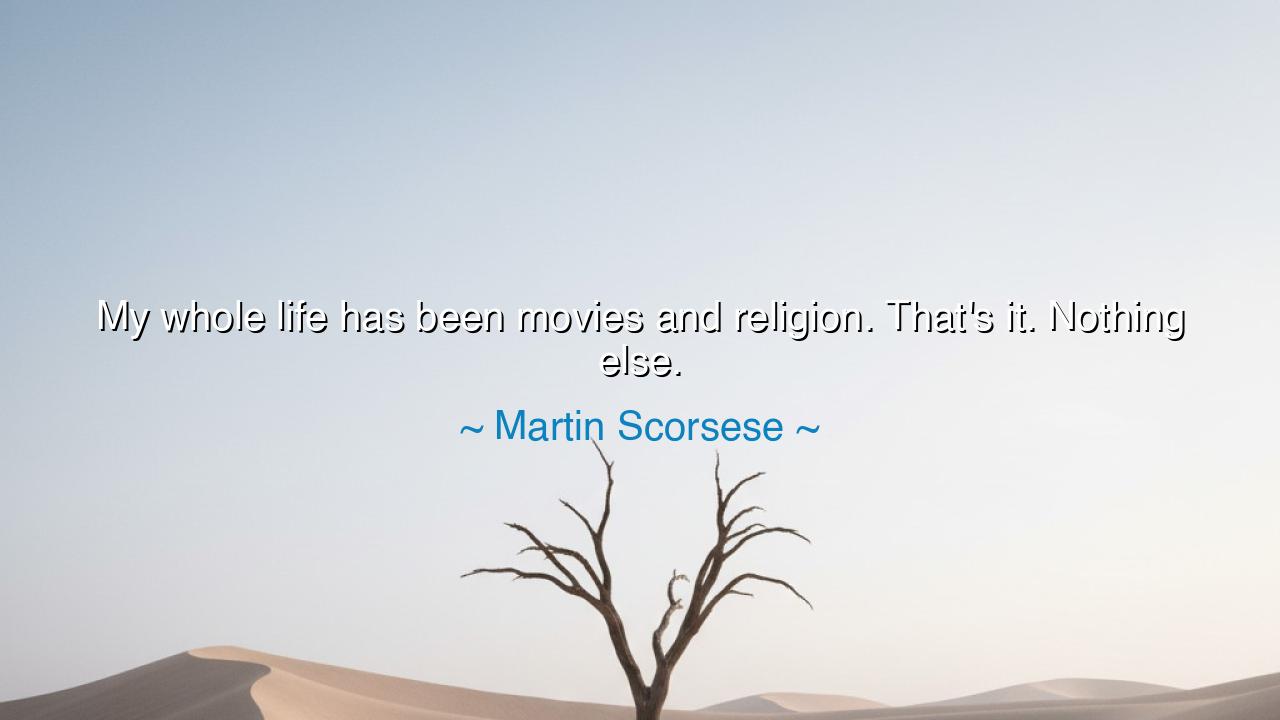
My whole life has been movies and religion. That's it. Nothing






“My whole life has been movies and religion. That’s it. Nothing else.” Thus spoke Martin Scorsese, one of the great visionaries of modern cinema, whose art burns with the dual fire of faith and obsession, of sin and redemption. In these words, he bares the essence of his soul—an artist torn between two sacred callings: the church and the cinema. For Scorsese, the screen became his altar, and film his liturgy. His life has been a lifelong struggle between the light of belief and the darkness of human weakness, between the yearning for salvation and the fascination with sin. This quote is not a boast—it is a confession, spoken with the honesty of a man who knows that the two great forces of his existence have never been at peace, yet have always been one.
To understand his words, one must understand the man behind them. Martin Scorsese was born in 1942 in Little Italy, New York, the son of Sicilian parents and the child of the Catholic Church. Frail in health and often confined indoors, he found sanctuary in two places: the flickering light of movie theaters and the solemn glow of church candles. He once considered becoming a priest, for religion offered him structure, meaning, and redemption. Yet cinema called him with another kind of holiness—a freedom, a truth that spoke not through doctrine but through emotion. Thus began his lifelong journey to reconcile these two devotions—the sacred and the cinematic, the pulpit and the projector.
When Scorsese says, “That’s it. Nothing else,” he speaks of total surrender—the kind that saints and artists share. For every great creator is a believer, not always in God, but in the divine power of his craft. Movies, to Scorsese, are not mere entertainment—they are confessions, prayers, and explorations of the soul’s conflict. His films—Taxi Driver, Raging Bull, The Last Temptation of Christ, Silence—are not about heroes or villains, but about men caught between sin and grace, yearning for transcendence. In his art, the violence of the streets mirrors the violence of the soul, and redemption is always possible, though never guaranteed. Cinema became his religion, not because it replaced faith, but because it allowed him to speak its language in a modern tongue.
This marriage of faith and art recalls the legacy of the great Renaissance masters. Consider Michelangelo, who painted the ceiling of the Sistine Chapel not merely as an artist, but as a servant of God. His brushstroke was prayer, his suffering devotion. Like Scorsese, Michelangelo struggled between human passion and divine calling. He loved beauty as much as holiness, and in that tension, he created works that transcended both. So too does Scorsese labor within his own duality—the gangster’s brutality beside the priest’s compassion, the sinner’s despair beside the saint’s longing. For him, cinema is the cathedral of modern man, where questions of faith are asked not in silence but in the cries of flawed souls.
And yet, Scorsese’s words are not about glory—they are about obsession. “Movies and religion. That’s it.” It is the confession of a man consumed by his purpose. To dedicate oneself so completely to two great forces is to live in both heaven and hell. His life reminds us that true devotion—whether to faith, art, or love—demands sacrifice. Scorsese has spent decades confronting the moral storms within himself, turning guilt into art, doubt into vision. His statement is both humble and immense: he acknowledges that life, for him, has never been about the multitude of things others pursue—wealth, ease, comfort—but about the pursuit of truth through his twin devotions.
But what lesson does this hold for us? It is this: to live fully is to live for something larger than yourself. Whether your altar is faith, creation, or compassion, pour yourself into it as Scorsese did. Do not scatter your heart among distractions—find the two or three great forces that ignite your soul and give your life to them. In the ancient world, men and women who devoted their lives to a single purpose—philosophy, art, or prayer—were called holy, not because they were pure, but because they were whole. Scorsese reminds us that holiness and wholeness are the same word written differently. When you find what your soul was made to serve, let it consume you.
So, my child of creation and conviction, learn from his confession: devotion is the fire that gives life meaning. Do not fear obsession, if what you serve is true and beautiful. Whether you seek God, art, or justice, pursue it with your whole being. Let your life, like Scorsese’s, become a film written upon the heart—a story of struggle, beauty, and redemption. For in the end, it is not the variety of one’s pursuits that defines greatness, but the depth of one’s devotion.
Thus, the lesson stands eternal: find your sacred calling, and give yourself to it. Let your work be your worship. For if you live with passion and faith—whether through the prayers of the soul or the art of the camera—then, like Scorsese, you will be able to look back upon your days and say with quiet conviction: “That’s it. Nothing else.”






AAdministratorAdministrator
Welcome, honored guests. Please leave a comment, we will respond soon